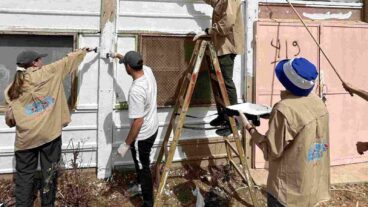The holiday of Tu B’Shvat is the New Year of the Trees. That’s a fact every Israeli schoolchild knows. But not everyone may be aware that Israel’s Parliament, the Knesset, celebrates it birthday on Tu B’Shvat. And every year, Knesset members (MKs) participate at tree-planting ceremonies around the country.
They continue a tradition that got its start on February 14, 1949 (the 15th of Shvat), the date of the first sitting of the Constituent Assembly, which took place at the Jewish Agency building in Jerusalem.

Most of the MKs, on their way to Jerusalem from the coastal area, stopped at Sha’ar HaGai (Bab el Waad) for what was to be the first annual Knesset tree-planting ceremony, led by Prime Minister David Ben-Gurion.
In Judaism, the 15th of Shvat is one of the four new years in the Jewish calendar and the starting date for the agricultural cycle. Associating the newly formed State of Israel’s legislative body with this holiday therefore symbolized renewal and growth.
The unintended — and humorously ironic — symbolism of connecting government with Tu B’Shvat stems from its original bureaucratic purpose: in Second Temple times this was the cut-off date for the annual tax on fruit, a 10% tithe paid to Temple servants and to the poor.
According to biblical nature reserve Neot Kedumim, “It is a period when there were no fruit on trees that grew in Israel in ancient times and therefore a logical date to establish the start of a new ‘fiscal year for fruit.’ The agricultural significance of Tu B’Shvat was lost when the Romans conquered Israel, destroyed the Second Temple, and scattered the Jews to the far-flung lands of the Diaspora.”
Tu B’Shvat continued to be commemorated by eating the grains and fruits of the Holy Land. After the expulsion of Jews from Spain in 1492 when the center of kabbalistic study moved to the Land of Israel and the city of Safed, students of the famous mystic Rabbi Isaac Luria created the Tu B’Shvat Seder. This was a festive meal celebrating the Tree of Life — the central mystical symbol of the kabbalah — through eating fruit of the Land of Israel, drinking four cups of wine, prayers and readings.

The modern custom of planting trees to celebrate Tu B’Shvat originated with the early Zionist pioneers. The first ceremony was held in 1884 at the agricultural community of Yesod HaMaaleh. Educator and historian Rabbi Ze’ev (Wolf) Yavetz is credited with holding the first school tree-planting ceremony in 1890 at the Zichron Yaakov agricultural school.

Keren Kayemeth LeIsrael-Jewish National Fund (KKL-JNF) credits the Teachers’ Association of Eretz Yisrael and teacher Chaim Aryeh Zuta with the first urban ceremony, held in Ahuzat Bayit (later renamed Tel Aviv). “In 5665 (1904), it [the Teachers’ Association] decreed Tu Bishvat as an Arbor Festival for tree planting in all the schools throughout the country.” (Other sources claim the first urban planting was in 1906 or 1908.)
In his 2014 paper, “From the town – and from the village? The Creation of Planting Ceremonies on Tu Bishvat“, Dr. Hizky Shoham of Bar-Ilan University states that the North American holiday of Arbor Day, founded in 1872 by Nebraskan newsman and politician J. Sterling Morton, (who also served as US Secretary of Agriculture), inspired the Zionist movement to transform Tu B’Shvat into the tree-planting holiday.
In 1901, the Fifth Zionist Congress established the KKL-JNF and by 1905, KKL-JNF had planted its first forest in Ben Shemen, a grove named in memory of Zionist movement founder Theodor Herzl. For many years, KKL-JNF, with its ubiquitous blue coin-boxes, was synonymous with tree-planting in Israel.

By the 1920s, tree-planting was the established secular Tu B’Shvat custom in pre-state Israel. Anthropologist Raphael Patai writes in his Encyclopedia of Jewish Folklore and Traditions, “Songs were specially written in its honor. ‘So Walk the Tree Blossoms‘ (written in 1926, with lyrics by Isaac Shenhar/Sheinberg and music by Yedidia Admon/Gorohov), ‘The Almond Tree Blossoms‘ (written in the 1930s, with lyrics by Israel Dushman and music by Menashe Rabinah/Rabinowitz). Even in the 1940s, these songs were considered folk songs. Today, they are taught to toddlers and in kindergartens as part of the preparations for the festival.”
It was only natural, therefore, that Ben-Gurion would make a pit stop, en route to the historic meeting, and celebrate the holiday as did the rest of his country.
From 1949 onwards, planting trees on Tu B’Shvat became an integral part of the Knesset’s birthday celebrations. As Tu B’Shvat evolved into a day of environmental and ecological awareness, the 2014 “Green Knesset” initiative has turned the Knesset into one of the world’s greenest parliaments.

















![Elections 1977 – Likud posters] In 1977, Menahem Begin led an election upset as Israel’s first non-Labor prime minister. Credit: GPO Elections 1977 – Likud posters] In 1977, Menahem Begin led an election upset as Israel’s first non-Labor prime minister. Credit: GPO](https://static.israel21c.org/www/uploads/2019/09/Elections_1977___Likud_posters_-_GPO-768x432.jpg)
